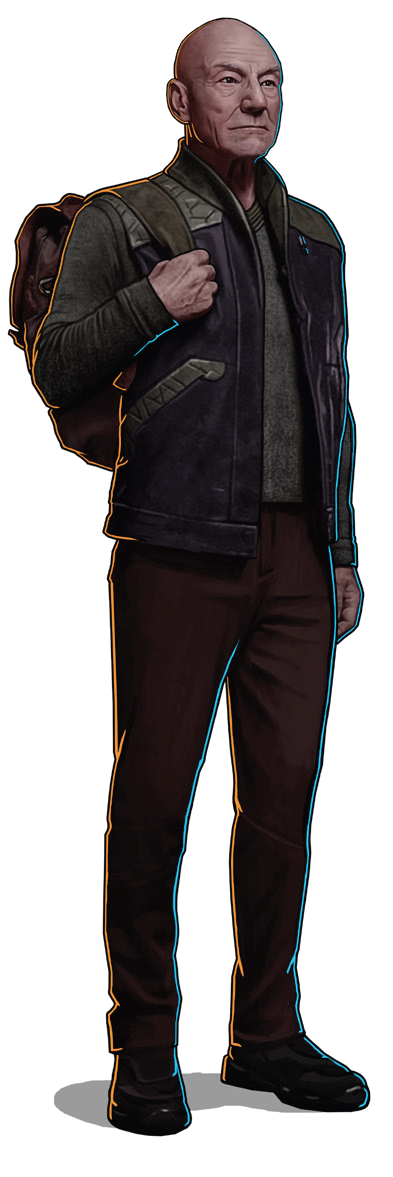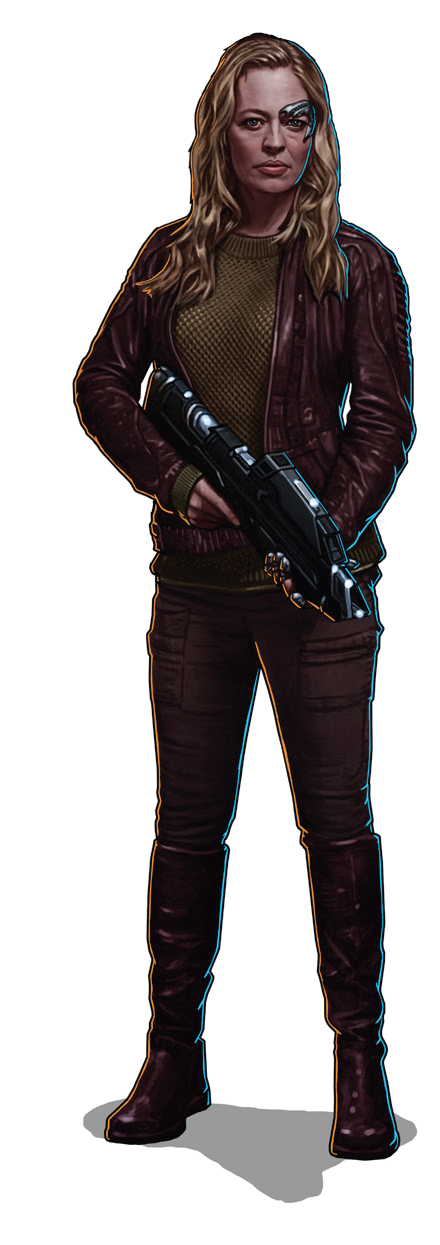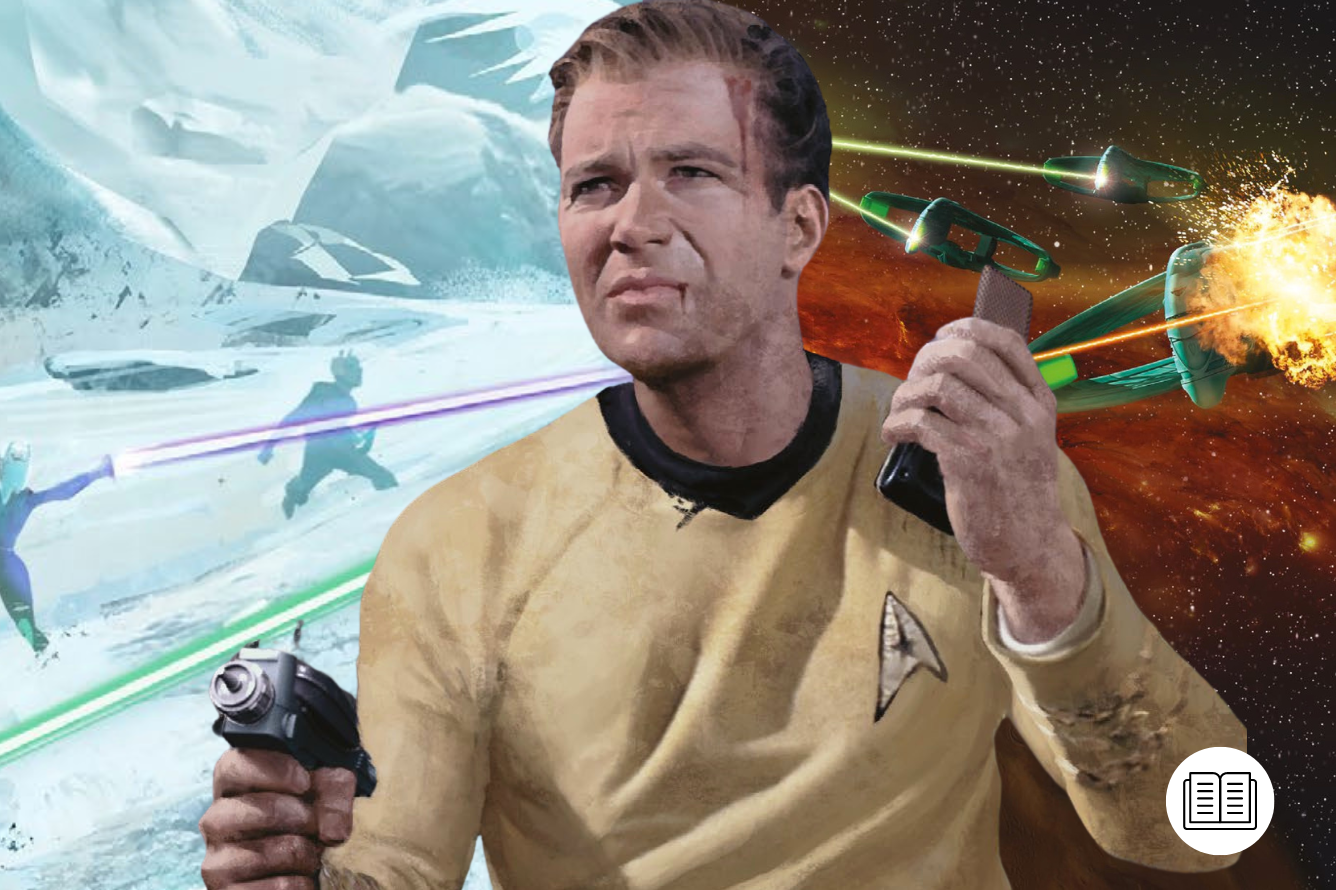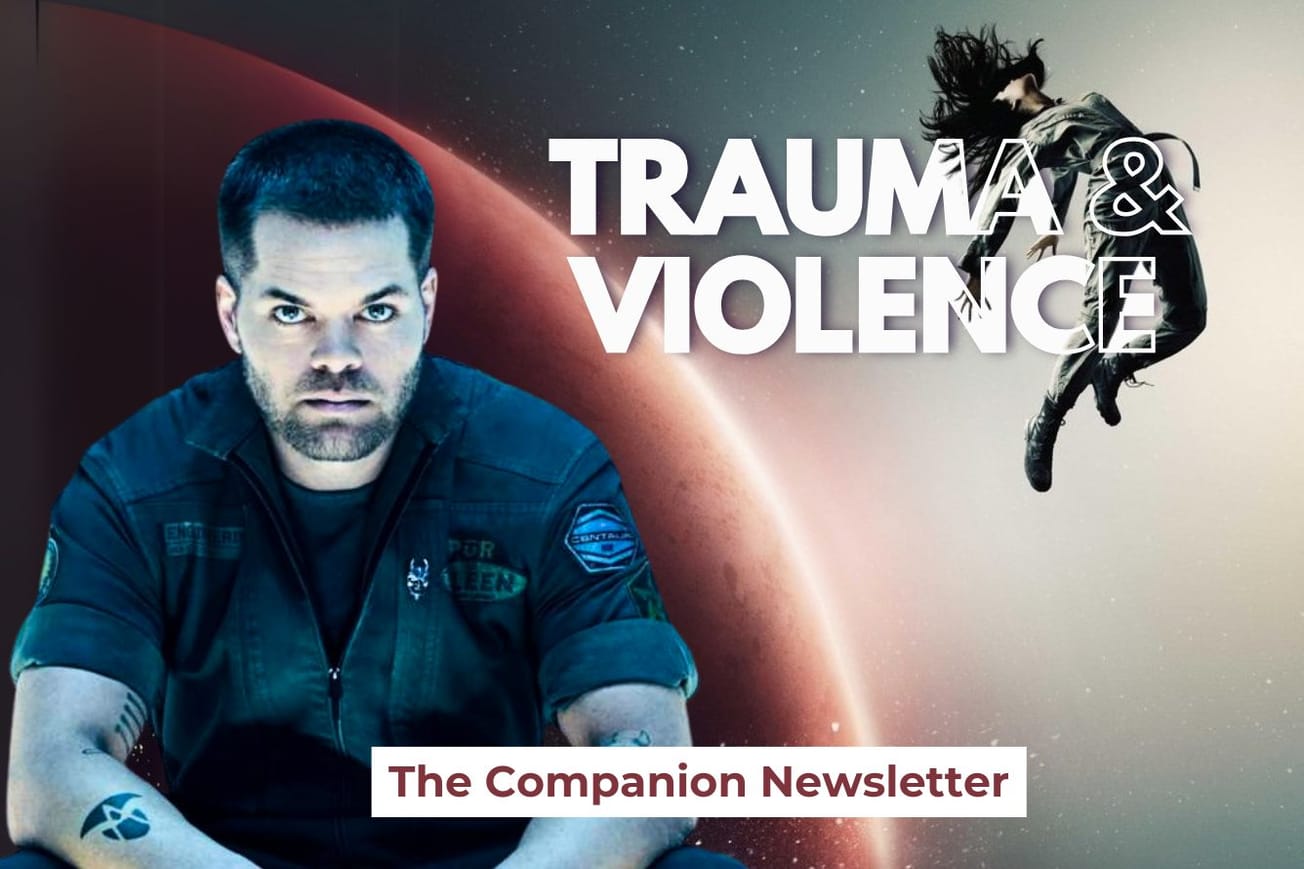Nobody at Modiphius would use the word reboot or relaunch, but there’s a sense in 2022 that the Star Trek Adventures line has hit a powerful piece of punctuation.
The core book was launched in 2017, followed by ‘division books’ for the different Starfleet careers – Command Division (2018), Operations Division (2018), and Sciences Division (2018) – and then sourcebooks for the key settings – Beta Quadrant (2018), Alpha Quadrant (2019), Gamma Quadrant (2020), and Delta Quadrant (2020) that expanded the range of playable races accordingly.
Star Trek Adventures was doing everything you expected a licensed TTRPG to do and in true Modiphius style, doing it well. Then last year, Jim Johnson – who as product manager is the line’s custodian – hit the full-stop and started a new paragraph with The Klingon Empire – Core Rulebook. It’s a curious beast, partly a red and black reskin of the original rules, partly a revision of them, and partly a sourcebook for life (and death) aboard a Klingon Bird of Prey. For Johnson, it was an opportunity to put some of their learnings from the last four years into effect.

“I don't know if this is a generational thing,” he muses, “but I've discovered that the younger generations of gamers are much more visually oriented than they are text-oriented. I grew up on D&D, AD&D, Star Frontiers – all the classic RPGs, and those were all very text heavy to [the point] where you were basically reading a technical manual. Infographics weren't really a thing, like step-by-step pictures of how to do things – three columns of text, you need a magnifying glass to read it all but that's how we learn the games, right?
“Now, especially with, you know, online gaming, and Twitch and Twitter and YouTube, I think a lot of gamers are learning visually now, more than they ever have before. I think if I had been able to have done something about it five years ago when we were doing the core book, I would have tried to present the rules graphically, as well as textually. Just to make it clear – you can tell a good story with a picture, you know, much more effectively than you can a 500-word block of something. We tried to do that a little bit in the Klingon book because we took an opportunity to refresh the core rules and we added some tables and some charts and even some flowcharts. Like here's how combat goes: step one, step two, step three.

“My learning is if we ever have an opportunity to do another refresh on the core book, or maybe even a revised edition or a second edition or something, I want to take a lot of those procedural things in the mechanics and try to try to visualize it so that somebody can look at a page and say, ‘Yep, that's how combat works.’ And they don't have to think too hard about it. They just see the flowchart, or they see the pictures or whatever, and then they can move on and play.
“I think we're doing a great job presenting Star Trek for an RPG audience, but now the biggest challenge is there's a perception that the game is complicated. And really, the game is not complicated, but you gotta get through the text to figure that out.”
Making the Gamemaster’s Guide and Player’s Guide
If The Klingon Empire – Core Rulebook was a backdoor pilot for a new era of Star Trek Adventures, it's the recent Gamemaster’s Guide (2022) and the Player’s Guide (2022) that serve as a statement of intent for the line’s values and aims.
If you’ve been around roleplaying for long enough, you’re conditioned to see these sorts of books as being a thinly disguised vehicles for new races, character classes, magic items, or monsters. What they very rarely are, are useful guides on how to run or play a game in that system. The Gamemaster’s Guide lays out Star Trek’s values, themes, and the secret sauce that makes a Star Trek story, and how that recipe is tweaked from show to show. (For fans of a certain vintage, it’s a pretty clear break with FASA’s overly technocratic Star Trek: The Roleplaying Game from 1983). The Player’s Guide follows suit, with tips on how to make your character’s shipboard role unique to them (play the character, not the character class, kids), and how to support your fellow players and your GM in the telling of the story.

“The game's been out for almost five years now,” explains Johnson, “and in that five years of time, Modiphius has developed a whole bunch of new games using the 2d20 system. And we've had four years' worth of feedback from the fans about how things work and all the questions they've been asking about the ruleset. I knew this was an opportunity for us to do a real honest to god Gamemaster’s Guide and Player's Guide that talks about how to take the existing game and be more effective with it or do it more coolly or try to answer some of those questions that keep popping up all the time.
“I wanted to get away from the traditional D&D Player’s Guide mindset – it was just like more stuff, but it didn't really, I don't remember them really offering advice on how to play the game more effectively, how to be a more effective Star Trek roleplayer, how to how to have a good session zero with your group… We just haven't seen that kind of advice for a lot of games and we didn't have the opportunity to put a lot of that into the original core book for Star Trek. This was totally a design choice to be intentional about that.”
Star Trek Adventures Is Dedicated to Getting Trek Right
Part of what makes Johnson the perfect hand on the helm is not just his attention to detail (he proudly points out that his structure for the Command Division sourcebook was used as the template for the rest of the series), but how deeply steeped he is in Trek lore. Jab him with your d'k tahg and he bleeds Andorian blue, having contributed short stories to the anthologies Star Trek: Mirror Universe Shards and Shadows (2009), and Star Trek: Strange New Worlds VIII (2004), IX (2006), and X (2007). With The Klingon Empire – Core Rulebook, that all comes proudly to the fore, not just in terms of Johnson’s own knowledge, but in the team he surrounds himself with on Star Trek Adventures.

“I've been a Star Trek fan all my life and I've got Scott Pearson on the team. He's the lead freelance copy editor for all the Star Trek novels, so he's on top of the lore. I brought a bunch of writers who I knew knew Klingons. Keith R.A. DeCandido [and] Dayton Ward have done a lot of Star Trek novels over the years, and they know their Klingon stuff way better than I do because they do this stuff all the time. All the writers, I brought on board know Star Trek, and know how to research, not so much just going through, you know, Wikipedia, or Memory Alpha or whatever, but go into the source material, watching the episodes, getting the information,[and] figuring out what characters to include.”
He also enlisted the services of the Klingon Language Institute, perhaps the most elevated authority on science fiction’s most vibrant conlang (constructed language).
“I knew that the fans would know this stuff and they would call us out if we got it wrong. So I wanted to make sure that if we put any language in the book, I wanted it to be right. So I reached out to Dr. Schoen at the Klingon Language Institute, and got him involved to write the foreword, and then to provide some of the translations in the book.”
Putting Star Trek Adventures into Context
At the time of this interview, the Star Trek: Discovery (2256-2258) Campaign Guide – a sourcebook detailing the backdrop to Star Trek: Discovery’s first two seasons and the brutal war with a resurgent Klingon Empire – was a glimmer in Johnson’s eye. It speaks to the fact that five years is a long time in Trek. When the core book was published in 2017, Star Trek: Discovery hadn’t aired yet. Now we’re four seasons in, and the show has been joined by Star Trek: Picard, Star Trek: Lower Decks, Star Trek: Prodigy, and Star Trek: Strange New Worlds.
“We knew Discovery was coming when we were putting the core book out,” says Johnson. “But at the time, we didn't even have the license for Discovery. We had all the legacy series, but we didn't have Discovery yet. Then just as we started developing products CBS and Paramount started cranking out new shows. We're like, ‘Wow, there are opportunities ahead of us if we do all this right.’
“One of the things that CBS and Paramount want to do is they want to try to get the different Star Trek licensees working together and interacting with each other and kind of cross-pollinating,” Johnson explains. “We've got connections with Star Trek Online and just all these big, other licensees that do art and ships and all kinds of stuff. The fans appreciate it. They'll read one of our books and say, ‘Hey, I saw this artwork in the Star Trek Timelines game’, or, ‘Hey, this ship is literally right out of Star Trek Online’.


“It helps bring all those different licensees to Star Trek together and try to present them as a cohesive whole. It doesn't always work but that's just what I'm trying to do. So you have Picard and Lower Decks and everything on the air right now, and there are so many people on social media talking about their work on these series. And social media has made it so easy to reach out to people all around the world. I can watch and say, ‘Hey, you worked on this, do you have any points of contact where I can talk to you about stuff?’ or, ‘You want to write for the game?’ and just go from there.”
Eagle-eyed fans will have already seen vessels designed for Star Trek Online pop up in Star Trek: Picard Season 2. The game’s art director Thomas Marrone proudly took to Twitter to point out that his Sutherland-class scientific research vessel, Ross-class exploration cruiser, Gagarian-class battlecruiser, and Reliant-class light cruiser was now firmly canon.
#startrekpicard I can't really say how much this means to me, to have @trekonlinegame thanked in the credits of a live @startrek TV show. pic.twitter.com/4rbVEwsQxC
— Thomas Marrone (@thomasthecat) March 3, 2022
The canonization of Star Trek Adventures might be a little longer coming, but it’s for no want of effort and evangelism on the part of Modiphius. The digital crew packs for Picard Season 1 and all four seasons of Discovery give you character sheets for the core cast, rules for playing Romulans and Kelpians, and stats for USS Discovery and La Sirena, but there’s also a 26-page digital supplement for IDW’s Year Five comic book that picks up the story of The Original Series during the final year of its five-year mission.

“There hasn't been an opportunity for us to impact canon or to get into the show or anything,” says Johnson. “I suspect that a lot of the producers or the people working on different shows have probably read Star Trek Adventures. And we've certainly reached out to them and said, ‘Hey, anytime you want any of our material, we're happy to send you a care package of books and PDFs.’ I would love it if one of the shows dropped in a reference to the Shackleton Expanse or something just to validate it. But in the meantime, we're going the opposite direction.
“So a licensee will do something and will make a product... a great example is IDW did the recent Year Five comic book series, which is an amazing comic book series about the last year of The Original Series. And we reached out to them and said, ‘Hey, you're finishing up this series. It's an awesome series, and we'd love to do some sort of game supplement to support the final release of it, can we do this?’ And they were like, ‘Yeah, we can work with you.’ So they provided just a tonne of artwork from the series and we wrote up a 20-page PDF digital release, with characters and content in it and we just dropped their art right into it. So it was just a way for us to take another licensee's work, and reimagine it for the game. The fans really appreciate it because they could go read the comic book and then literally pull that comic book content into their games. I'd love to do more of that.”
How Little Worldbuilding is Too Little?
Covering the ongoing shows presents a different set of challenges from the legacy shows. Things that matter to TV shows aren’t the same things that matter to roleplayers, and it explains why, in part, the most successful game lines adapted from TV or movies are like Star Wars or Middle Earth, based on incredibly detailed, lived-in universes where we come to the game with an idea of what people eat, where they go for entertainment, and what their home lives are like.
These are things that the GM needs to know because they’re the sort of questions that are posed by the actions of their players. If you’re setting a game on Deep Space Nine in the immediate aftermath of the Dominion War, you know from seven glorious seasons and 176 more-or-less glorious episodes what its visitors eat, what type of people you might encounter in Quark’s, and who is first on the scene when your problematic PC decides to spark out a Bajoran vedek for looking at them funny. A ten-episode season of Star Trek: Picard, on the other hand, gives you much less to play with because that sort of detail isn’t shaded in until the plot of the show requires it so unless your game is entirely about retired deck officers running a vineyard in a sun-bleached French chateau or a group of Romulan engineers stripping copper wire from a beached Borg Cube, a sourcebook is of limited use.

“One of the challenges we discovered, especially with Picard, is we wanted to do a good product that covered a lot of content. And there just wasn't a huge amount of content in Season 1. Then we knew and then you're just hearing through the grapevine or hearing the press releases that Season 2 was coming, Season 3 was coming. It's like ‘Okay, well, let's hold off a little bit’. Let's wait. And then you know, do a fuller product once Season 2 comes out and Season 3 comes out.
“We're trying to present the world, present the franchise, present the setting as they did on the shows, but as an RPG, we have to go into detail that they don't have to worry about. They just do all these big storylines, which is great. But then it's like, well, how do civilians operate? Or how does money work? Or how does food work? It's like, ‘Oh, shoot, we have to explain all this stuff in a game context.' So if you're playing a character in this setting, what do they know? How do they operate? How do these things work?
“So that's part of what the Player’s Guide and the Gamemaster’s Guide were trying to do is just try to provide a baseline understanding of the technology and the setting, so that somebody who's new to Star Trek, who doesn't know that 55 years’ worth of stuff that we all know, because we've been, you know, steeped in this forever. I had to remind myself that there are new fans coming into Star Trek, who only know Lower Decks, or only know Discovery or only know Picard. Maybe they'll watch a couple of episodes of the old series, but they just don't know Star Trek, as well as somebody who's been around for a while. So I wanted to try to give them an opportunity to get on board.”
Creating a Single Design Language for Star Trek Adventures
Consideration for the radically different possible entry points to Star Trek Adventures in 2022 compared to Star Trek Adventures in 2017 can also be seen in the design. Whilst the core book is heavy on the bright and bold LCARs iconography of the TNG, DS9, and Voyager era, the Player’s Guide and Gamemaster’s Guide go for a lighter, more series-neutral tone.
“Most of our products have been aimed at The Original Series, or Next Gen era, layout look and feel. We have a couple of Enterprise adventures and products out there too that we've been able to design an Enterprise look and feel but for Gamemaster and Player’s Guide I was like, ‘Okay, well we have a franchise now that has like eight different shows and they all look different. And we need to come up with a unified Star Trek design that evokes Star Trek, but isn't necessarily Original Series or Next Gen or DS9 or Discovery or whatever – it's Star Trek.
“Like a lot of Star Trek fans, I have a lot of resource material and a lot of products from all kinds of different companies that have made Star Trek books over the years. So I just took it upon myself to take a long weekend and I just started flipping through all these different books just looking at their design layout, just the aesthetic of how they are presenting Star Trek and having it not become that specific series. I just started taking notes of what I was seeing these different designs look like and then I reached out to the designer who was tasked with creating the interior layout design for the Player’s Guide and Gamemaster’s Guide. I guess it was about a month of just coming up with design ideas and finally, we got it to a place where we were happy with it.

“These two books are the first time for the line, where we were able to present a unified Star Trek look and feel to the book, you're like, ‘Yes, this is definitely Star Trek, even though it's not Discovery, or it's not Picard. I think we'll probably do that in future books depending on which ones we end up putting together, just because we're at the point now where we have five new series in current production, and they're all different. Picard, Discovery, Lower Decks, Strange New Worlds, and Prodigy all have a very different look and feel. But they're all still Star Trek.
“With the Player’s Guide and Gamemaster’s Guide, we had a lot of conversations internally about like, how, how do we present this, like, how are we going to sell this book to people? Like, do we want to do an Original Series cover, a Next Gen cover, and a Discovery cover? And have three different covers of the same book out there? And just like, you know, see which one does the best? Do we want to put that cost into it? Or do we just do like one really cool cover for Star Trek and hope for the best?
“And some of the questions that we have to answer, you know, ask ourselves when we're developing products now is like, who's our target audience? Is it specifically Discovery fans? Or is it everybody? And obviously, as much as possible, we want to try to appeal to everyone.”
This article was first published on October 6th, 2022, on the original Companion website.
The cost of your membership has allowed us to mentor new writers and allowed us to reflect the diversity of voices within fandom. None of this is possible without you. Thank you. 🙂










